Max Allan Collins's Blog, page 3
July 15, 2025
A Hell of a Review, Film Festival News & A Quarry Review
Once upon a time, Kirkus Reviews gave my work some of the worst notices I ever received anywhere; they were downright mean. It’s even rumored that the despicable murder victim, Kirk S. Rath, in my Mallory novel Nice Weekend for a Murder, was named in their “honor.” No doubt I’ll get another bad review from them, before I leave the planet. But you know what?
They love Barbara Allan. Shhhhh! Don’t ever tell them I am half of that team, though undoubtedly my wife Barb deserves the lioness’ share of the credit.

Here’s the lovely Kirkus review of the forthcoming Antiques Round-Up.
ANTIQUES ROUND-UP Author: Barbara AllanSevern House Pages: 208 Price (Hardcover): $29.99 Publication Date: October 7, 2025
Mother and daughter antique dealers take a trip to Texas, where all hell breaks loose.
Vivian Borne is a bipolar woman of many talents. Her daughter, Brandy Borne, is a divorced mother who takes antidepressants and dotes on her diabetic shih tzu, Sushi. Their shop sales need a boost, and since they’ve recently done well with Western antiques, Vivian’s motivated by an ad for a citywide yard sale to head to Tranquility, Texas, where she thinks they can score some bargains. Brandy’s fiancé, Tony Cassato — the police chief in their hometown of Serenity, Iowa — has a history with the daring duo that gives him little hope they’ll stay out of trouble. From the start, the trip doesn’t go well. They get a flat tire, they get lost, they get stuck in a ditch, they get stuck sleeping in a very odd motel. Awakened by the police, they’re arrested for damaging a replica of Cherokee life in the 1800s.
Tony gets them out of jail, but their arrival in Texas is marked by even worse trouble. Vivian, looking to get ahead of the competition, rents a horse and visits several sellers she’d talked with about purchasing certain items before the sale starts. Her first two meetings go well, but her third meeting with a Mr. Tool is cut short when she turns up his body, shot in the head. Since she’s already paid for a necklace, she searches for it and finds it just as the police arrive. With a long string of solving mysteries to their credit, the pair must solve this one to stay out of jail.
A rollicking story of crime fighting includes plenty of antique-buying tips and some Texas-style recipes.
I am pleased to say we have received many good reviews over the years for our Antiques/Trash ’n’ Treasures series, and not just from Kirkus. It’s gratifying, but we are pretty sure this is the first time a reviewer has started out by observing that “all hell breaks loose.”
Right now Barb is working on her draft of the next book in the series (which she always begins by telling me this will be the last one – we’re up to 20, I think). She is diligent and painstaking about the process in a way I admire very much.
There is nothing in my writing life more pleasurable than working on my draft from Barb’s first draft. Actually, what Barb hands off to me is not really a first draft, because it’s polished as “all hell,” to invoke Kirkus. How our collaboration works is this: we agree on a basic plot, very basic, the idea always coming from Barb, who says she needs a personal connection to the material. She writes a draft shorter than what we’ve been contracted to deliver. Let’s say (although this varies) she gives me 250 pages that I need to expand to 300 pages.
What do I do? I add even more humor (there’s always plenty), write action scenes she has skipped (leaving me a note to “take it away”), expand dialogue scenes when her short story roots start to show, and suss out any plot holes, of which there are few if any. Barb is very good about letting me do as I wish, as long as I don’t trip over the plot. That’s a possibility because I do not read her draft before I begin mine, which is a revision and expansion of hers, working directly in her draft. So the in’s and out’s of the mystery are often news to me when I reach them. If she can surprise me, she’ll surprise you.
I ask her how she can work so hard on something – a minimum of six months – and then hand it over to me, saying only, “Do whatever you want. I’m sick of it.”
She’s as good as her word.
I would say she is Brandy, more than she’s Vivian; and I am more Vivian than she is Brandy.
If you’re a fan of mine, and have avoided these novels because they are sold as cozy mysteries (which they are, but subversively so, a fact an Ellery Queen Mystery Magazine reviewer once pointed out), you should try one. You can always slip the inevitable cute dog cover off and only return it when you’ve completed reading it and shelving it spine out.
Confession: we love the cute dog covers.
There is further good Brandy and her mother news, by the way. Our Antiques indie film, Death by Fruitcake, has been chosen to be an official selection of another film festival – the Iowa Independent Film Festival. Keep in mind we only entered seven festivals and have been official selections of three. (Two festivals haven’t announced yet.)
What’s significant is the rule-of-thumb is…you are lucky to become an official selection of one festival out of ten that you enter. So we’re already ahead of the curve. We have limited ourselves to only Iowa fests, with the exception of the New Jersey Mystery, Crime & Horror Film Festival, which seemed right up our alley. Tough competition there (but, really, everywhere).
We are also looking seriously at three avenues of distribution, and should have an announcement soon.
Here is the official press release about the upcoming Star City Festival and my being honored there. It does not include that our film Death by Fruitcake will be screened on Saturday, August 2, at 6 pm with Q and A after.
Max Allan Collins Guest of Honor at The Star City Film Festival Waukon, Iowa July 31-August 3rd
News provided by
EIN Presswire
Jul 10, 2025, 10:05 AM ET
WAUKON, IA, UNITED STATES, July 10, 2025. The Star City Film Festival Returns to Waukon, Iowa for Its 8th Season
Celebrating Film, Creativity, and Community – July 31 to August 3, 2024. Special Guest of Honor Max Allan Collins.
The Star City Film Festival is thrilled to announce its return for the 8th season, taking place from July 31 to August 3, 2024, in the charming town of Waukon, Iowa. Founded and directed by the talented Dr. Katie O’Regan, this year’s festival promises to be an unforgettable celebration of filmmaking, featuring 40 diverse films, live performances of three new film scripts as radio plays, a glamorous red carpet premiere, and engaging talk-backs with attending filmmakers.
This year’s festival will honor Iowa’s very own Max Allan Collins, a celebrated figure in the world of film noir and a best-selling author, producer, and director. Max is renowned for his work on the Academy Award-winning film adaptation of his graphic novel, “Road to Perdition.” He has been recognized by the Mystery Writers of America as a Grand Master and has received an impressive twenty-three “Shamus” nominations from the Private Eye Writers of America, with notable wins for his Nathan Heller thrillers.
Max’s extensive body of work includes not only his acclaimed novels but also contributions to comics, film criticism, and several successful screenplays, including the Lifetime film “Mommy” and the HBO World Premiere “The Expert.” His creativity also extends to the world of documentaries, with “Mike Hammer’s Mickey Spillane” featured in the Criterion Collection.
Joining Max at this year’s festival is his wife, Barbara Collins, an esteemed short story writer and production manager for various independent film projects. Together, they have co-authored bestselling novels that showcase their unique storytelling abilities.
The Star City Film Festival aims to create a platform for filmmakers and audiences alike to connect, inspire, and celebrate the art of cinema. Attendees can look forward to a lineup of films that highlight emerging talent, as well as discussions that delve into the creative process behind the stories told on screen.
Join us in Waukon for a celebration of film, creativity, and community for all the activities including a live street dance and outdoor music with “Corn Days” happening at the same time!
For more information about the festival, ticketing, and programming details, please visit www.sacrednoisesociety.org
Dr. Katie O’Regan interviewed me, and I think it’s one of the better ones I’ve given in a while.
* * *Here is an expanded version of my San Diego Comic-Con appearances, now including signings.
San Diego Comic-con 2025 Schedule
Thursday, July 24:
11am panel “Leave Them in Suspense” 23ABC (Mysterious Galaxy)
12:30pm signing AA09
Friday, July 25:
4pm “Spotlight on MAC” 28DE (Robert Meyer Burnett)
5:30pm signing AA23
Saturday, July 26:
10am signing booth 2001 (new Johnny Dynamite book)
Sunday, July 27:
11:00 panel (Titan with Andrew Sumner) 32AB
Apparently because Hard Case Crime has released a new trade paperback of The Last Quarry (previously only available in traditional mass-market paperback), a few reviews for that 2006 novel, which ignited a new run of Quarry novels, have begun to pop up. I’ll be starting the next soon (actually, noodled some on it this morning).
Here’s one of these reviews.
* * *Here’s where you can stream the late great Michael Cornelison in Eliot Ness: An Untouchable Life.
As I’ve been interviewed about returning to indie filmmaking late in life after a twenty year hiatus, it’s occurred to me that this loss of Mike was the reason. Mike was involved in every one of my productions – he acted in Mommy, Mommy’s Day, Real Time: Siege at Lucas Street Market, and Eliot Ness: An Untouchable Life, plus narrated both Mike Hammer’s Mickey Spillane and Caveman: V.T. Hamlin and Alley Oop.
And my impulsive move back to filmmaking was deciding to film our radio-style play, Mickey Spillane’s Encore for Murder. It was originally produced as an audio-only production starring Stacy Keach as Mike Hammer…and Michael Cornelison as Pat Chambers.
* * *Please check back in with me next week before Barb and I leave for the San Diego con on Wednesday. The update after that will likely be photos from the con, particularly of my panels with my pals Rob Burnett and Andrew Sumner.
M.A.C.
July 8, 2025
Mommy Has Her Day & San Diego Looms
It’s nice, even rewarding, to see the two Mommy movies we made here in Muscatine, Iowa, back in 1994, get renewed attention. Mommy’s Day came out in 1996, so we’re coming up on its 25h anniversary. Mommy celebrated her 25th anniversary last year.
What prompts me to discuss this is a nice review by Tony Baranek of Mommy (and another by Henry Kujawa of Mommy’s Day that just popped up. Tony’s Facebook page is dedicated to Sci-Fi and Horror Movie Playground: 40s, 50s, 60s, 70s, 80s, 90s and Beyond.
Here’s Tony’s review:
Mommy (1995) – Do you remember that 1950s movie, The Bad Seed, where Patty McCormack played the psychopathic killer kid? Man, she was nasty.I mean, when Rhoda Penmark was electrocuted by the lightning bolt at the end, I cheered.
(NOTE FROM M.A.C.: Rhoda lives in the original William March novel and in the Maxwell Anderson play from March’s book.)
But I’ll tell you what. Rhoda Penmark is a sweetheart compared to Mrs. Sterling, a psychopathic killer mom.
Yes, indeed. Patty McCormack is all grown up – and she’s scarier than ever!
This horror thriller is about a 12-year-old girl named Jessica Ann (Rachel Lemieux), whose overbearing mom goes off the deep end when she didn’t win Student of the Year award for the third straight time.
Just for acting like a spoiled and entitled mom, Mrs. Sterling is an embarrassment to the human race. But she doubles down on her ugliness because she claims that the boy who won it only did so because he’s Mexican. Yep, she’s entitled – and racist, too.
Mrs. Sterling confronts the teacher while she’s decorating her classroom. She demands that she change her decision on the award before it gets presented. The teacher sternly says no.
Moments later, crazy Mrs. Sterling pulls the teacher off of a ladder she is standing on, and she suffers a fatal injury. She tells the police, though, that the teacher was already dead when she arrived at the classroom.
Unfortunately for Mrs. Sterling, a persistent investigator named Lt. March (Jason Miller), has his doubts. And as the walls begin to close in on Mrs. Sterling, bad things happen to those who cross her.
This is a really well-done film. Max Allan Collins, in his directing debut, added a nice touch to the story by having Jessica Ann narrate the events as they happened. Rachel Lemieux, 11 years old at the time and in her acting debut, did a fantastic job portraying Jessica Ann. As an added bonus, scream queen Brinke Stevens is ultra-likeable as Mrs. Sterling’s caring sister.
As for Patty McCormack as Mrs. Sterling…man, oh man. Being a killer made her scary enough, but she was an absolute nightmare mom. Her declarations of love for her daughter – but only if she does exactly what mommy tells her to – are incredibly unnerving.
Grade: 4.5 out of 5 stars.
* * *A mini-review from Henry Kujawa of the sequel, Mommy’s Day, appeared almost simultaneously.
Here’s what Henry had to say.
After all these years, I still haven’t seen The Bad Seed.However, the other year, I got Mommy and Mommy’s Day on DVD. I think I “liked” the first one less the 2nd time I saw it (decades after I first saw it). But I was shocked as JUST HOW MUCH I loved the sequel.
I kept wondering… “HOW THE HELL is this even gonna work?” Then I started watching…STILL wondering…and then…
OH man. Maybe 15 minutes in, I was HOOKED. I think I had a huge smile on my face all the way thru to the end. It still makes me smile, even laugh, just thinking about it.
If only more “2nd” films managed to be that good.
* * *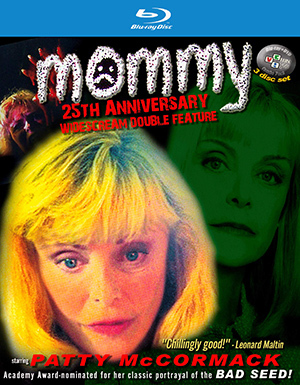
If you haven’t seen either Mommy before, you can get it at Amazon for a good price. It comes with Mommy’s Day and lots of special features.
Incidentally, Paula Sands – who is Vivian Borne in Death by Fruitcake – appears in a major secondary role in Mommy’s Day.
Interesting, the sequel to last year’s horror hit Megan – which seemed to have some Bad Seed/Mommy echoes – looks to have followed the Mommy’s Day model with its sequel, Megan 2.0. I have not seen the sequel but eventually will. The complaint is that Megan is turned into a hero(ine) in the second film.
Doing a sequel, particularly to a horror film (and Mommy is that, at least marginally), provides two options – repeat the first movie or do something different. While audiences like the familiarity of a sequel that merely goes through the first film’s paces, doing something different (or the same-but-different) is far more appealing to a filmmaker (or author, for that matter). And smart audience members.
The current Jurassic World: Rebirth is a good example of just repeating what’s gone before and hoping audiences just go along for the ride. On opening weekend, filmmgoers seemed to – it did very well at the box office.
But it’s a fairly terrible movie. Predictable and with bone-headed characters who do dumb, dumb things. It starts with the premise that everybody is bored with dinosaurs by now – an idiotic premise, and anyway, in this movie it’s the characters we’re bored with (stock figures) and the dinosaurs that make it marginally watchable. It has about 17 minutes of terrific dinosaur footage, but even they are a disappointment, because they only devour the cannon-fodder characters and of course (SPOILER ALERT but not really) the evil corporate bad guy.
* * *Here’s a nice advance look at the 4K Blu-ray of The Two Jakes, which features a commentary by me and my pal Heath Holland. The commentary gives me the opportunity to defend this much maligned sequel (actually coda) to Chinatown with Jack Nicholson back as Jake Gittes.
Here’s where you can see Road to Perdition free.
And, yes, yet again an article about movies you didn’t know derived from “comic books” has reared its head. I prefer “graphic novel,” when it comes to Road to Perdition. Plus, these endless write-ups on the subject of movies-from-comics is a bit wearying.
On the other hand, I’m grateful for the attention.
* * *I am still doing a segment on Robert Meyer Burnett’s weekly YouTube show, Let’s Get Physical Media. This week I discuss, among other things, the terrific movie Sinners, which I am pleased to say seems heavily influenced by Road to Perdition (more the movie than the book). And, yes, I am aware there are no vampires in Road to Perdition. An oversight on my part.
If you go the San Diego Comic Con, Rob Burnett will be interviewing me:
FRIDAY“Spotlight on Max Allan Collins”
4:00 – 5:00
Room 28DE
This will be a career interview (all Special Guests get those). Not sure yet when my autograph sessions will be, but I will be promoting the new Johnny Dynamite collection, with a banger of a new Terry Beatty cover. The book is expected to be on sale at the con, though the timing is tight – stay tuned. It’s one of the Collins/Beatty team’s best, I think.
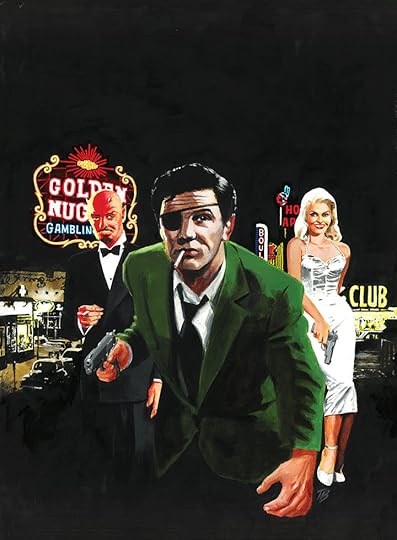
There are no vampires in Johnny Dynamite, but there are plenty of zombies.
By the way, this is almost certainly my last comic convention appearance, at San Diego or anywhere. I will do some occasional appearances at film festivals, promoting Death By Fruitcake and other indie endeavors of mine.
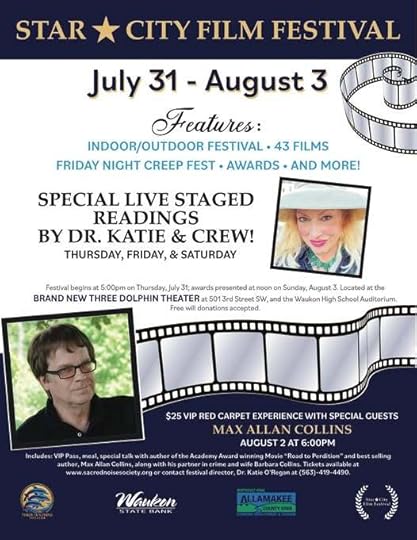
M.A.C.
July 1, 2025
Capitol Crime, The Dark City & San Diego Comic Con Schedule
Here’s a trailer for Cap City aka Mickey Spillane’s Cap City.

This movie is something director David Wexler and I have been working on for some time. The idea was always for me to adapt the Spillane/Collins novella, A Bullet for Satisfaction, into a film. The novella shared space with The Last Stand in the Hard Case Crime-published book of that title.
The script went through various iterations. Originally, as in the novella, the lead character, a tough detective in a corrupt town, was male. For various reasons, it was decided I’d rewrite it for a female lead, a la Ms. Tree.
The projected budget was in the very low millions, and we came close to getting it financed. But it never quite came together, and finally David was ready to move on; but I suggested I rewrite it to mostly play on one set, a technique I had used on Blue Christmas. This excited the director, my envisioning a way to go from low-budget to micro-budget and still get the story told.
So I rewrote the script accordingly.
Ironically, David wound up shooting Cap City during the same two-week period that I shot Death By Fruitcake – two movies of mine shooting simultaneously! I had to turn down a trip to the east coast to be on set for Cap City because I was busy.
I’m very pleased with the finished result of Cap City (and Fruitcake of course). David is preparing to take it out to festivals, and I may be screening it in the Quad Cities in August as part of the non-competitive festival, Alternating Currents. That looks likely but not a sure thing just yet.
More to come on that front soon.
In the meantime, here is David’s biography:
David Wexler is President of Cinema 59 Productions. He is a writer/director based in New York City. Prior to his feature films (EVIL WEED, THE STAND UP, ANCHORS, TURTLE ISLAND, LAST SUPPER, VIGILANTE), David focused on television, creating and producing the critically acclaimed reality show “College Life” for MTV.Wexler’s film, Motorcycle Drive By, about Third Eye Blind, was an official selection of the 2020 Tribeca Film Festival. Most recently, his film Disintegration Loops was an official selection of the 2021 SXSW Film Festival.
Cinema 59 often works with Creative Diversions (a Toy/Game company) to create 360 degree entertainment.
* * *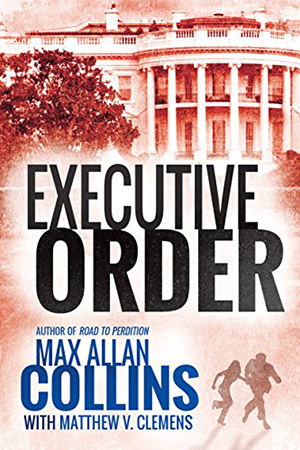
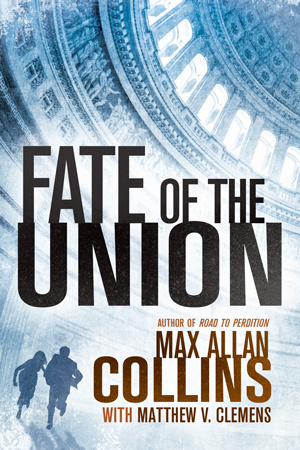
Executive Order and Fate of the Union will be promoted via Amazon’s Monthly Deals, starting 7/1/2025 and running through 7/31/2025, each will be offered at 2.99 USD during the promotion period. (This is e-book only.)
These are book two and book one of the Reeder and Rogers Trilogy. Supreme Justice is not part of this offer, but it’s available here.
The trilogy by Matt Clemens and me has proven unfortunately prescient, particularly Supreme Justice, which has gone on to be one of my bestselling titles, just behind Road to Perdition and Saving Private Ryan.
* * *Cleveland Magazine has put out a “read local” booklist and the first of my Eliot Ness novels, The Dark City, is on it. I might have preferred Butcher’s Dozen, but a recommendation is a recommendation.
Here is where you can get The Dark City.
* * *For those of you who asked where my movie Mommy could be streamed, the link is here.
* * *Finally, here is the schedule for my panels at the San Diego Comic Con.
SAN DIEGO COMIC CON PANELS 2025THURSDAY
“Leave Them in Suspense”
11:00 AM — 12:00 PM
Room 23ABC
Panel will include Ted Van Alst, Jr., Max Allan Collins, Arvind Ethan David, Shane Hawk, Holly Jackson, and Catriona Ward. This panel will be moderated by Mysterious Galaxy.
FRIDAY
“Spotlight on Max Allan Collins”
4:00 – 5:00
Room 28DE
Robert Meyer Burnett (Robservations) interviews Max Allan Collins (Road to Perdition) on a career ranging from Dick Tracy and Ms. Tree to the current all-star immersive ten-chapter audio drama, True Noir: The Assassination of Anton Cermak, based on Collins’ Nathan Heller series.
SUNDAY
“Max Allan Collins: A Titan at Hard Case Crime: From Ms. Tree to Nolan to Heller to Spade & Hammer!”
11:00AM – 12:00PM,
Room: 32AB
Andrew Sumner interviews Max Allan Collins on the author’s work at Titan Books and sister company Hard Case Crime.
M.A.C.
June 24, 2025
Death by Fruitcake an Official Film Festival Selection
Death by Fruitcake, my latest indie movie, is going out to a limited number of film festivals, mostly in Iowa, which will better enable us to attend ourselves. (A slightly revised version of our poster is shown here.)

As you will see below, the Star City Film Festival has chosen us as an Official Selection, as well as screening the film in a prime spot on Saturday night August 2nd. Thirty-three other films are showcased in the festival, so this in itself is a nice honor.
We have already done nicely at the Iowa Motion Picture Awards and hope to do well at Star City. As I said, we are mostly going out to Iowa festivals and limiting the number of fests we’re entering to half a dozen. They say getting one acceptance out of a ten entries is a good result, and we have two out of six (so far).
Work continues to get Death by Fruitcake onto a streaming service. It’s unlikely we’ll have a DVD and/or Blu-Ray until the 2026 holiday season.

Here’s the press release about the Star City Festival:
The Star City Film Festival Returns to Waukon, Iowa for Its 8th Season – Celebrating Film, Creativity, and Community – July 31 to August 3, 2024Special Guest of Honor: Max Allan Collins
Waukon, Iowa – The Star City Film Festival is excited to announce its return for the 8th season, taking place from July 31 to August 3, 2024, in the charming town of Waukon, Iowa. Founded and directed by filmmaker, musician, and writer, Dr. Katie O’Regan, this year’s festival promises to be an unforgettable celebration of filmmaking, featuring 40 diverse films, live performances of three new film scripts as radio plays, a glamorous red carpet premiere, and engaging talk-backs with attending filmmakers.
This year’s festival will honor Iowa’s very own Max Allan Collins, a celebrated figure in the world of film noir and a best-selling author, producer, and director. Max will premiere his new film Death by Fruitcake, which he wrote and directed, on Saturday evening of the festival. Following the screening, he will participate in a live talk-back session, providing the audience with insights into his creative process and the making of the film.
Max is renowned for his work on the Academy Award-winning film adaptation of his graphic novel, *Road to Perdition*. He has been recognized by the Mystery Writers of America as a Grand Master and has received an impressive twenty-three “Shamus” nominations, with notable wins for his Nathan Heller thrillers. His extensive body of work includes acclaimed novels, contributions to comics, film criticism, and several successful screenplays, including the Lifetime film Mommy and the HBO World Premiere The Expert. His creativity also extends to documentaries, with Mike Hammer’s Mickey Spillane featured in the Criterion Collection.
Joining Max at this year’s festival is his wife, Barbara Collins, an esteemed short story writer and production manager for various independent film projects. Together, they have co-authored bestselling novels that showcase their unique storytelling abilities.
The Star City Film Festival aims to create a platform for filmmakers and audiences alike to connect, inspire, and celebrate the art of cinema. Attendees can look forward to a lineup of films that highlight emerging talent, as well as discussions that delve into the creative process behind the stories told on screen.
Join us in Waukon for a celebration of film, creativity, and community, with activities including a live street dance and outdoor music during “Corn Days,” happening simultaneously!
For more information about the festival, ticketing, and programming details, please visit [](http://www.sacrednoisesociety.org).
By the way…our previous indie movie, Blue Christmas, is available on DVD and Blu-ray at Amazon and other cyber retailers. It’s also streaming, and this link will give you a rundown on where you can see it free (often but not always with commercials) and can rent it.
I do beg you to understand these are micro-budget films (micro-budgets defined as “a movie made with very limited financial resources, typically under $250,000, and sometimes even under $100,000 or $50,000.”
* * *I seem to be a more or less regular segment on Robert Burnett’s Let’s Get Physical show on You Tube (usually airing at 2 pm on Sunday afternoons, Central.) I talk about recent releases on Blu-ray and 4K discs having to do with crime/mystery movies.
This week Rob’s co-host Dieter Bastian had a work conflict and I was asked, at the last minute, to sub. Nobody can adequately fill in for the unique presence of Deets (as Dieter is called), but I did my best.
Director Rob and I shamelessly plugged our ten-episode audio drama, True Noir: The Assassination of Anton Cermak, every change we got, pretty much making a running joke out of it. (Nonetheless, we encourage you to go to truenoir.co and order it, if you haven’t already.)
The show often runs very long, and this week – as Rob and I went down numerous rabbit holes – lasted over three hours. Here it is, but be warned: I’m not kidding about that how long it went.
Here’s a great write-up on the forthcoming Blu-ray of The Two Jakes, which includes a commentary by my pal Heath Holland and me. Thrilled to be part of this release as Two Jakes is one of my favorite films.
Heath and I also did a commentary for Rustler’s Rhapsody, well written up here.
M.A.C.
June 17, 2025
Quarry Up for an Award, Mike Hammer’s Big Announcement
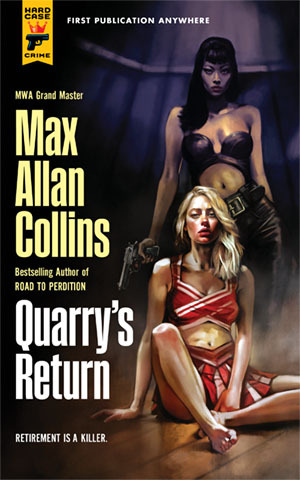
Things have been popping around here. First came news that Quarry’s Return has been nominated for the Best Paperback Novel “Shamus.” The Shamus is an award that means a lot to me, because my late friend Bob Randisi and I, and a few others, were grousing to each other about the Mystery Writers of America ignoring private eye novels in their Edgar awards. Bob was not one to let the grass grow under his feet and very soon he’d created the Private Eye Writers of America and the Shamus awards.
Arguably, the Shamus awards became the second most-prominent and prestigious honor of its kind in mystery fiction. Others have come and gone, and some may lay claim to being more important now; but I know and remember what it meant to me.

In 1983 my novel True Detective was published and got quite a bit of attention in its approach to merging the PI story with historical crime, and for being the longest private eye novel ever written (later my novel Stolen Away would eclipse it). I was, predictably, ignored by the Edgars but got a Shamus nomination. I was a long shot to say the least, because I was up against a Murderer’s Row of mystery writers: James Crumley, Stanley Ellin, Loren Estleman and Robert B. Parker. But my book won, and I was boosted considerably in the business…and both Nate Heller and I are still around. Stolen Away won the Best Novel in 1992. The series went on to be the most-nominated in the history of the organization.
Anyone who says awards don’t matter (like me, when I lose) are full of it. If Bob Randisi hadn’t started up the PWA, I wonder if Heller and I would still be around.
Nate Heller and True Detective are the basis, of course, of True Noir: The Assassination of Anton Cermak, director Robert Meyer Burnett’s ten-episode audio drama from my adaptation. (truenoir.co)
Quarry has been nominated for the Shamus several times (my hitman even got an Edgar nomination last year for Quarry’s Blood) but I don’t recall him ever winning. Kind of makes sense in the PWA, because to make a private eye out of Quarry, you have to squint and look sideways. But the books are very much built on the private eye novel paradigm.
In other private eye news…
Matthew McConaughey is serious talks with Skydance about reuniting with True Detective writer Nic Pizzolatto in the Mike Hammer movie that has been threatening to happen for a decade or so.

The film is based not just on Mickey’s work but draws upon the entire series (including the collaborative novels and short stories that share a Spillane/Collins byline). I have read the script and it’s solid; as an executive producer, I was able to provide notes, to get the characters and concepts in line with Mickey’s and my work.
This news exploded all over the Internet. I lost count at 21 articles. Here’s a typical one from Deadline.
It was everywhere, from Variety to the Hollywood Reporter. I am optimistic but I never believe this kind of thing till I’m on set and the cameras are rolling. But it has a real feel to it.
You will note a certain irony here: the title of my novel True Detective is of course the title of the (later) HBO series that brought together actor McConaughey and writer Pizzolatto – a highly rated and regarded series that I have never seen, since the use of the title irked me. On the other hand, I plucked the title from the vintage true-crime magazines that were on the newsstands when Heller was starting out in the other True Detective.
* * *Here’s a cool review of The Last Quarry.
My band the Daybreakers has a Wikipedia page! And I didn’t submit it much less write it (a few inaccuracies, but hey).
M.A.C.
June 10, 2025
Damn Fool Crusader, Dick Tracy, Wayne Dundee R.I.P.
Through my dalliances with YouTube, I’ve been able to connect with some interesting people, who have become my friends or at least friendly acquaintances. I spend a little more time watching YouTube than I should, because my wife Barb and I almost always watch a movie in the evening, and sometimes my son Nate comes over (after he helps his wife Abby get his two kids to bed) (Sam and Lucy), making it a double feature. My beddy-bye time is, roughly, midnight and I sometimes have an hour or so to fill before closing out my day. The morsels of entertainment I encounter on YouTube are fun, often informative and, usually, not demanding.
This past week I did a commentary with Heath Holland of the respected Cereal at Midnight on the Chinatown sequel, The Two Jakes, which is one of my favorite movies but not a terribly well-regarded film. It was my opportunity to defend the film and explain myself. This commentary was for the upcoming 4K Blu-ray to be released by Kino Lorber.
Heath is a knowledgeable pop culture expert with an emphasis on film and music, as well as a winning presence on Cereal at Midnight, which appears sporadically but frequently on YouTube. We’ve done several movie commentaries together for Kino, and have several more to do. He’s a pleasure to work with.
I of course have a great creative relationship and friendship with Robert Meyer Burnett. Here’s him talking about our collaboration, True Noir: The Assassination of Anton Cermak, as a guest on a YouTube show dating back a few months (we hadn’t announced Michael Rosenbaum as our Nate Heller yet). The passion, talent and skill that director Rob Meyer Burnett brings to True Noir: The Assassination of Anton Cermak is on full display in this interview (done while we were stilling working on the True Detective adaptation – available at truenoir.co). (Not “com” – “co”!)
More recently I connected with one of the most unique presences on YouTube, Spencer Draper, who calls himself The Damn Fool Idealistic Crusader. He discusses pop culture with an emphasis on genre movies (and books), but has become known, well outside YouTube circles, as a watchdog for flaws on DVDs, Blu-rays and 4K discs. He points out mastering problems and particularly hones in on audio blunders. He is focused, relentless and very, very smart.
I reached out to him to inquire about his experiences on the Warner Bros “DVD rot” problem, which has to do with a batch of 2007-2008 DVDs that are out there rotting even as we speak. He’s been key in alerting collectors and a sometimes (sometimes) cooperative Warner Bros customer service about the problem, and the need – moral responsibility for – replacing defective discs.
There’s a spooky aspect to the contact between Spencer and me. I’ve never gotten in touch with him before, and I don’t believe he’s ever covered anything of mine on his YouTube offerings. I had no reason to think I was on his radar.
But it turns out he was, at that moment, doing a deep dive into my involvement with the Dick Tracy movie, studying my novelization and doing his general thorough digging job. We have now corresponded several times and the experience has been pleasant, even if the Warner Bros aspect hasn’t been. (I am definitely not talking about Warner Archive!)
For Spencer, and for those of you who are new here (even relatively so), I am reprinting an article about how I intersected with the Dick Tracy movie, Warren Beatty’s people, and the Good Folks at Disney. It’s an excerpt from an article I wrote for Lee Goldberg’s Tied In – The Business, History and Craft of Media Tie-In Writing. It is the behind-the-scenes amusing and horrifying story of my writing of the movie tie-in novelization of Dick Tracy.
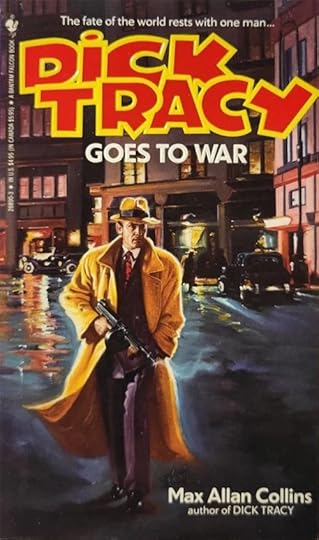 I wanted to write the Dick Tracy tie-in novel because I’d been the writer of the syndicated strip since 1977, plus I was a mystery novelist. Landing the Dick Tracy strip was my first really big career break. I got the job after trying out for it, writing a sample continuity. I got the opportunity to try out chiefly because of some mystery novels I’d written as a kid that had a strong comics element (Bait Money and Blood Money, both 1973).
I wanted to write the Dick Tracy tie-in novel because I’d been the writer of the syndicated strip since 1977, plus I was a mystery novelist. Landing the Dick Tracy strip was my first really big career break. I got the job after trying out for it, writing a sample continuity. I got the opportunity to try out chiefly because of some mystery novels I’d written as a kid that had a strong comics element (Bait Money and Blood Money, both 1973).My re-boot of the strip got a lot of positive attention, and I loved the job, having been a stone Dick Tracy fanatic since childhood. Before getting the strip, I had even developed a friendship with creator Chester Gould – a rarity, because he was very private – although Chet played no role in my landing this plum assignment.
Some time in the ’80s, I was shown a potential screenplay for Dick Tracy, shared with me by my Chicago Tribune Syndicate editor. I thought it was lousy, and told him so, and he agreed. I figured that was the end of it.
But the Dick Tracy film was a project that wouldn’t die – Clint Eastwood was going to be the square-jawed dick for a while, which was exciting, and then finally Warren Beatty got obsessed with it, and it became a Disney project and a very big deal. I offered to do the novel version and, thanks to my credentials as the writer of the strip, got the gig. I was thrilled.
Then they sent me the screenplay – it was virtually the same lousy one I’d read seven or eight years before! I was shocked and dismayed. Lots of the classic characters, villains and good guys alike, some good situations…but no story. Not really.
I asked my agent what to do about it, wondering what kind of novel I could fashion from such weak material, and he said, “Just do whatever you want with it. Nobody’s going to read it at Disney – this is just small change to them.” Did I mention that my usually very savvy agent had never sold a tie-in before? And that this was the worst advice he ever gave me?
So I wrote a novel very loosely based on the screenplay. I added more characters from the strip, provided a story, even replaced what seemed to me to be unimaginative death traps with my own better ones. It was a terrific little novel, designed by and for a Dick Tracy fan like me.
I sent it in, went on about my business, and several months later my wife Barb and I were preparing to go on a research trip to Nassau (for my Nate Heller novel Carnal Hours) when my agent called with bad news. The Disney people hadn’t even made it through my book – got maybe a third of the way – before saying a faithful-to-the-screenplay page one rewrite was needed.
In seven days.
Dick Tracy is legendarily a movie that Warren Beatty micro-managed. Every tie-in aspect was overseen by Beatty and his top people. The novel I’d written was inappropriate for any film. To have taken these liberties on Dick Tracy was a blundering piece of farcical arrogance on my part that makes Fawlty Towers look like a documentary.
So with a 1989-era laptop (think about it), I went to Nassau and spent 70% of my time in the hotel room salvaging what little I could from my first version. Maybe 25% of it was workable. Actually, some of my non-screenplay stuff made it in, because it didn’t contradict anything (Vitamin Flintheart is in my novel, for instance, but not in the film, not even deleted scenes).
Barb and I were in Nassau four or five days, and I came home and wrote the rest of it, just blazing. What I came up with was pretty good. I was as happy with it as possible, considering the weak screenplay that was my source. But that, as they say, was just the beginning….
I spent many, many hours on the phone with the producer of the film, Barry Osborne (later involved in The Lord Of The Rings trilogy), a gracious, intelligent man, and way too far up the food chain to be giving a lowly tie-in writer such instructions as, “The chair on page 223? It’s green not red,” and, “You have 88 Keyes standing up from the piano too soon on page 187.” Most of the changes I was asked to make had to do with such surface things, and many substantial changes I had made in character motivation and dialogue were overlooked.
This was perhaps the most instructive thing I learned from the experience – if you follow the screenplay out the door, and do the surface of it accurately, you can slip in all kinds of substance where characterization and fleshing out of scenes are concerned.
Osborne actually liked the novel a lot, and he told me on several occasions that I had solved plot problems for them, which they had fixed by way of dialogue looping – and indeed the film has five or six lines I wrote.
Also, he asked me about a scene involving Tracy’s girl friend Tess and her mother, where Mrs. Trueheart says a lot of negative stuff about Dick, how she is delighted that Tess and Dick have broken up and how selfish the detective is, etc. I had softened this scene, making Tess’s mother much more positive about her potential son-in-law. The producer asked me why I’d done that.
“Because,” I said, “Tracy joined the police force to avenge the death of Mrs. Trueheart’s husband – Tess’s father, who ran a deli and got shot by robbers. Mrs. Trueheart adores Dick Tracy. Every Dick Tracy fan knows that.”
And they re-shot the scene along my lines.
So I take a certain pride in knowing that Dick Tracy is a film in part based upon its own novelization. The final battle, however, reached new heights of absurdity, and involved phone calls with high-level folks at Disney. How high level? How about Jeffrey Katzenberg? The “surprise” ending of Dick Tracy is that the mysterious masked bad guy called the Blank is actually Breathless Mahoney. Sorry to ruin it for you, but, yes, Madonna did it.
This surprise seemed painfully obvious to me, the kind of shocker you can damn near figure out in the opening credits. But Beatty, Disney and all associated were convinced they had a surprise on the level of The Sixth Sense (I figured that out, too, about five minutes in). So I was instructed to remove it from the novel.
Wait a minute, you’re saying. Remove what? The identity of the masked bad guy. The solution to the mystery. You know…who the killer is.
This surprise ending, the Disney folks told me, had to be guarded like the Coca Cola recipe or the unretouched Zapruder film. And when I pointed out that Dick Tracy was a mystery story, and that leaving the ending off a mystery story just might disappoint a few readers, this seemed of no particular import.
I did half a dozen rewrites of the ending, sneaking in hints of the Blank’s identity, such as, “Why, look who it is under the mask…” said Tess, breathlessly. No sale. About a page was cut from the book.
I won only one small concession – that any printings after the film came out would include the full ending. Only one small print run represents the complete novel (the sixth, distributed to school book clubs).
There can be no doubt that I hold a singular honor among mystery writers – I wrote a bestselling whodunit… without revealing whodunit.
Perhaps by way of apology, the Disney people flew my wife, son, mother and father and me to the film’s premiere at Disneyworld in Florida. They treated us great. Everybody attached to the movie treated us great, including Warren Beatty. We did a big press get-together with many of the stars. I was doing a Mumbles continuity in the Dick Tracy strip at the time, and Dustin Hoffman (who played Mumbles in the film) read me that day’s strip from a local paper, doing Mumbles’ dialogue in character. Doesn’t get much better than that.
Two postscripts: in our Disneyworld hotel, a coloring book on sale – an item that (it turned out) had been available to the public for several weeks – included the Breathless-is-the-Blank ending. As we say in the funnies, “Sigh….”
Also, the wonderful actress Estelle Parsons (who played Mrs. Truehart in the film) wandered into a bookstore at Disneyworld, where I was signing copies of my open-ended novel. We spoke, and she was very sweet, and I said to her, “You had to re-shoot your big scene, didn’t you?”
She looked at me, amazed. “How did you know that?”
And I told her.
* * *I have no idea how long I’ve been writing these Update/Blog entries, but it’s been long enough that I’ve had to mark the passing of friends and heroes, as well as friends who were heroes.
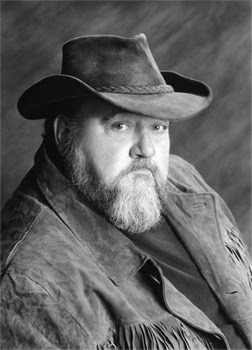
Wayne Dundee
I can’t say Wayne Dundee, who passed away recently, was a close friend. There was a time when we were. Seeing him gone does make me feel like the Last Man Standing – of my closest mystery crew, we’ve lost Ed Gorman, Bob Randisi, Steve Mertz, John Lutz, Bill Crider and probably more that I am criminally forgetting.
Wayne was the founding editor of the long-running fan/prozine Hardboiled (more “pro” than “fan” because it was always a paying market). He was one of the first fans who reached out to me, and he specifically wondered if I had anything in my drawer that he might print in his ‘zine, which ran mostly to (as you might imagine) hardboiled crime and detective fiction. As it happened, I did. A novel called Mourn the Living with a character initially called Cord and later Logan and even later (and permanently) Nolan had been stored away long ago.
I got the moldering manuscript (literally, not figuratively) out of a box in the basement and talked Barb into retyping it for me. She did this, gracious partner and writer that she is; and I did a light edit, not wanting to interfere with what the young writer (I’d been 19 when I wrote it) had in mind. Wayne, who specifically described himself as a Nolan fan, eagerly took it and had me break it into several parts for serialization.
Eventually it was collected into a book, and it was recently a bonus feature of sorts in Mad Money, the latest reprint of my Nolan-heists-a-shopping-mall novel, Spree.
Thanks, Wayne.
I vaguely recall reading Wayne’s early work in manuscript, and providing some notes and encouragement; but that memory is vague. I do know he went on to do nine Joe Hannibal mysteries, wracking up several Shamus nominations. A career as a private eye writer is hard to maintain (tell me about it!) and he eased quite naturally into becoming a highly regarded western writer. The last time I heard from him, and it was a post here, was him encouraging me to show my grandson western movies, and to agree that Costner’s Horizon was woefully under-appreciated.
Wayne also appeared in one of my movies! He was the hulking, bearded prison guard who backed up the great Del Close in the scenes regarding the botched attempt to execute Mrs. Sterling (aka Mommy).
James Reasoner, one of the other last men standing, writes a brief but lovely tribute to Wayne here.
* * *I seem to be a more or less contributor of a segment to Rob and Dieter Bastian’s infectious YouTube show, Let’s Get Physical Media. I’m on as a noir/crime/mystery expert. The weekly episodes usually are on Sunday afternoon, and I have been coming on around 2 pm Central for half an hour or so.
M.A.C.
June 3, 2025
Pee-Wee Herman, Death by Fruitcake & San Diego Comic-Con
The two-part HBO documentary, Pee-Wee as Himself (directed by Matt Wolf) hit me hard. It was, in many respects, delightful; but to revisit the unfair attacks on Paul Reubens, due to one ill-judged moment and a subsequent witch hunt, was a painful experience.
The Paul Reubens interviewed by Wolf (a great job by Wolf on this) was the Paul I knew – a pleasant, quietly witty soul who could be frank and guarded, all at once. He’s very funny in the doc, but Wolf wisely included Paul struggling with how deep to dive into himself. He dove pretty damn deep, actually.
The one thing that struck me most was how Paul and Pee-Wee had, on some level – again, a deep level – merged into one for these final trips in front of the camera. The playful Paul, and the private one, seemed to struggle with each other throughout – but the very sweetly funny man he was prevailed.
He made some enemies in his time here on earth. He was driven and that drive at times left people behind. I’ve spoken to several Groundlings (the Second City-style comedy troupe of which Paul was a part in L.A. at the start of Pee-Wee) who resented his success. You don’t reach the heights of show business without a certain coldness – asked about this in the doc, Paul shrugs and says, “It is show business.”
It’s tough to have the kind of large ego that leads to success without alienating some of those you meet along the way. I can only say that Paul’s generous, sweet nature that I encountered reminds me we were all lucky to know Pee-Wee Herman.
This is what I wrote about Paul and Pee-Wee before Christmas 2013. I’ve reprinted this before, but it seemed appropriate – even necessary – to share it again.
For me, Christmas begins when I receive my yearly Christmas card from Paul Reubens. Sometimes Paul writes a personal note. The cards are always charming and even hilarious, and we have easily two dozen of them. This year Barb made a wreath out of some our favorites.I went crazy over Pee-Wee with his HBO Special,
The Pee-Wee Herman Show in 1981. I was doing the DICK TRACY strip at the time, and I put Pee-Wee in the strip – he was on television saying, “My name’s Pee-Wee – what’s yours?” And a TV-obsessed villain of mine replied, “Splitscreen!”Paul Reubens phoned me shortly after that, delighted by the TRACY appearance, and we chatted. Shortly after that, taking time out from a San Diego con, Terry Beatty and I visited Paul in LA – he was in a small one-story brick house filled with funky toys and oddball memorabilia. We watched a version of
The Pee-Wee Herman Show that the cast had looped with blue improv material. The Pee-Wee Herman suit was on a coat tree. I asked Paul how many of those he had, and he said, “Just the one.” Then, noting my surprised reaction, he added, “Sometimes Pee-Wee doesn’t smell so good up close.”Paul knew that I was a movie buff, and he was working on getting a Pee-Wee film going. Late at night, we would talk on the phone and (at his request) I would send him Betamax copies of offbeat films like Eddie Cantor’s
Roman Scandals and Russ Meyer’s Faster Pussycat, Kill Kill! He called once every month or two for a couple of years, sometimes when he was off shooting a movie. (One was a Meatballs sequel, and I asked him what it was about. He said, “A virgin sees her first dick.” I thought he was kidding till I saw the movie.) Barb and I (and sometimes Terry) would go to live shows of Paul’s, and we’d see him after – we did this in New York and Chicago.When the Pee-Wee movies and TV show kicked in, Paul changed his phone number and I haven’t heard from him since…except at Christmas. Always a wonderful card, and sometimes a warm personal note. I still love Pee-Wee Herman, and it’s been a nice perk of my minor celebrity that I got to know Paul Reubens a little. It’s very thoughtful and generous of him to send me these fantastic cards every year.
After this blog entry of mine appeared, I heard from Paul, as follows:
Max, is this you?! I recently ran across this (the above Update): I’d love to catch up with you. I now (maybe, if this is indeed you) have an email address but don’t have a phone for you anymore. It sure has been a long time!I hope you’re reading this!
Paul
I was obviously thrilled by this re-communication, and on occasion would hear from him via e-mail, though we never spoke on the phone or in person again. Those Christmas cards kept coming. That’s stopped now, of course.
The last time I heard from Paul was when he thanked me for writing a tribute (here at the Update) about his friend and collaborator John Paragon, Jambi on Pee-Wee’s Playhouse and in the original HBO The Pee-Wee Herman Show. John had just passed away and Paul liked what I had to say about the man who’d perhaps been his most important collaborator. Here’s that tribute.
* * *The important news this week is that I will be a Guest of Honor at the San Diego Comic-con.
I have attended many times, and of course I performed with my bandmates in Seduction of the Innocent on numerous occasions at the con. I have only attended once since my 2016 heart surgery; the con that time around was an experience that was hard enough to have me staying home after that, reluctantly. That was 2018.
So this return visit is going to be somewhat physically tough, but I am delighted to be making this one-stop farewell tour. As it stands now, Andrew Sumner will be interviewing me about all my Titan/Hard Case Crime projects (over the last twenty years!) and Robert Meyer Burnett will interview me about Nate Heller (among other things) with an emphasis on True Noir: The Assassination of Mayor Anton Cermak.
When I say “farewell tour,” don’t panic (I’m not). I generally feel fine, but a-fib has its travails. Nonetheless, please know I will be writing novels and screenplays until they carry me out in a body bag. And they better zip it, or I’ll crawl the hell out.
* * *
We haven’t taken Death By Fruitcake out on the festival circuit, concentrating on getting it on a streamer(s). Right now there’s no DVD or Blu-ray scheduled, as that market has (except for some niche stuff) pretty much dried up.
But we did enter the Iowa Motion Picture Awards. We were nominated in five categories and won five awards. Barb and I did not attend the event, because we’d decided instead to be in Des Moines for an evening screening of Death By Fruitcake (as part of the festival). Two trips to Des Moines from Muscatine in four days was a little much. So our leading man, Rob Merritt, attended for us and picked up the hardware after.
We received awards in all five categories in which we’d been nominated – Director: Award of Excellence: Max Allan Collins; Award of Achievement Long-form Narrative: Death By Fruitcake; Actor: Award of Achievement: Rob Merritt; Actress: Award of Achievement: Paula Sands; and Supporting Actress: Award of Achievement: Alisabeth Von Presley.
We are obviously pleased.
And I will tip my cap to all of those mentioned above, and the rest of my cast and crew, who pulled off something special in a limited amount of time and budget. Particularly I will salute my buddy Chad Bishop, who shot the film, edited it and co-produced it.
 * * *
* * *At the suggestion of a potential distributer, we have added a subtitle to Death By Fruitcake. Now it’s DEATH BY FRUITCAKE: An Antiques Christmas Mystery. We think this was a good suggestion, because “Christmas” is a helpful thing as is tying the movie to its source, namely the Antiques series of cozy/crazy mysteries by Barb and me, writing as “Barbara Allan.” A novella of ours, Antiques Fruitcake, is the specific source.
* * *I got a big kick out of being part of the 200th episode of Let’s Get PHYSICAL MEDIA on YouTube this past Sunday.
Most Sunday afternoons, new episodes of this fun show with Robert Meyer Burnett and Dieter Bastian will air with segments from me talking about film noir and crime/mystery movies in general, specifically titles that have recently appeared on physical media. I’ll also be talking about True Noir, which Rob Burnett directed and I wrote from my first Nathan Heller novel, True Detective. True Noir: The Assassination of Anton Cermak is available now at truenoir.co.
M.A.C.
May 27, 2025
If Ms. Tree Falls in the Forest, Does Anybody Hear?
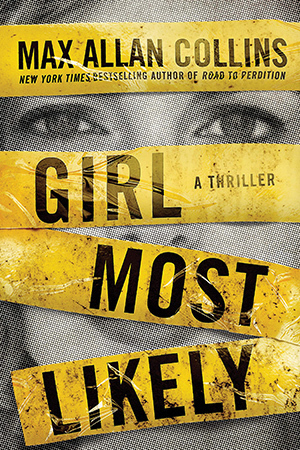
My novel Girl Most Likely will be promoted via Monthly Deals: starting 6/1/2025 and running through 6/30/2025, the first of the two (thus far) Krista Larson novels, offered as a Kindle book at $2.49 USD.
I love the two Krista Larson novels, but they (this one and Girl Can’t Help It) are the only two of my books that haven’t earned back their advance. This stands in the way of Amazon’s Thomas & Mercer ever doing business with me again, despite the fact that I’ve sold over a million books for them in other series.
So if you are a Kindle reader, and a M.A.C. reader, now’s the time.
* * *Back before e-mail and social media, Terry Beatty and I ran a lively letter column at the back of each issue of our Ms. Tree (the comic book that ran from 1981 to 1993). Terry, of course did the art and I wrote the scripts, although he and I had story conferences frequently, so it was a co-creation in its purist sense. Actually, the feature began as a serial in Eclipse magazine in 1981 and began as a comic book in 1982, shortly after the original – surprisingly successful – serial ended its six-issue run. I also wrote several Ms. Tree prose short stories, one of which (“Inconvenience Store,” the basis of my film (Real Time: Siege at Lucas Street Market) was published in 1994. And my Hard Case crime Ms. Tree novel, Deadly Beloved, appeared in 2007.
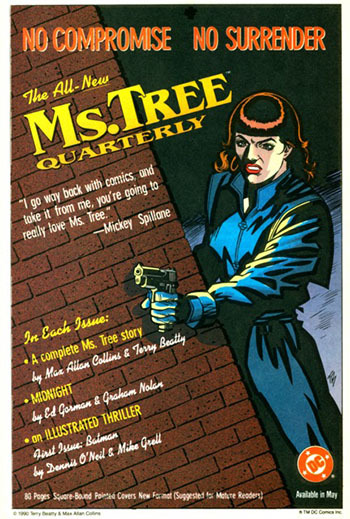
We accomplished quite a bit, except for the making a living part. We were the longest-running PI comic book in history, at least up to that date (I haven’t kept track of those who came after). We slightly pre-date the craze for female private eyes initiated by Sara Paretsky and Sue Grafton. We survived despite changing publishers four times, winding up respectable (after our indie run) at DC itself.
The letters column, SWAK!, was lively and popular. Mostly I answered the letters myself, and Terry answered art-specific stuff. Just as the comic book covered controversial subjects, so did the letters column. When we moved to DC, editor Mike Gold insisted we bring SWAK! along.
A lot of people got mad at us and at each other, but nobody reading SWAK! got bored.
Last week we heard from a SWAK! correspondent, whose letter was both a surprise and quite interesting. Here it is.
Dear Max & Terry,Max, it was so nice to hear from you. I was struck by your response when I suggested that you and Terry might do a MS. TREE special for Hard Case.
(This is what I told him: I doubt we’ll ever do another MS. TREE, as the character now seems so rooted in the ’80s and ’90s, that going forward, or for that matter backward, doesn’t hold much appeal.)
After 60+ years of collecting and 60+ boxes in my garage, I have stopped collecting comics for the most part, attempting to confine myself to rereading my favorite series, meandering from one part of my collection to another through free association.One thing I really enjoy is getting a better understanding of the influences that guided the creators of some of the wonderful series in my collection. So, for instance, I recently reread one of my favorites, Mark Schultz’ XENOZOIC TALES. Besides seeing the obvious Wally Wood influence, I learned of Schultz’ admiration and later friendship with Al Williamson. I did pick up Williamson’s FLASH GORDON issues and learned how he in turn was influenced by Alex Raymond.
In a way, what Schultz was doing with XENOZOIC TALES was very similar to what you guys were doing with MS. TREE and your “experiment in coherence” (as you put it). You both took inspiration from pre-code, pre-Wertham EC and modernized it with an unwavering commitment to writing and artwork at the service of storytelling. Form follows function. You guys were swimming against the tide at the time where books like Alan Moore & Steve Bisette’s SWAMP THING, with heavy prose and dizzying page layouts, were the rage. I love those types of books too, but undeniably the test of time has shone very favorable on your “experiment” proving beyond any doubt to the nay-sayers that there was method to your madness.
A foray into my favorite BATMAN series led me to reread the Englehart/Rogers run recently, where I made the startling discovery of the Collins/Rogers newspaper dailies. This, in turn, lead me to reaching out to you, Max, and subsequently rereading the entire MS. TREE run, turning your words over in my head as I did.
I must say, it all holds up extremely well. It is astonishing that the treatment of contemporary subjects of the ‘80s still seems fresh even though major changes have occurred like the overturning of Roe vs Wade and the widespread legalization of gay marriage. It just goes to prove that the French got it right when they say “the more things change, the more they stay the same.”
One of my favorite moments in the series was when Mr. Hand reveals to Mike Jr, that he had a gay lover when he was a mercenary. Mike Jr’s world view is imbued with a certain macho homophobia, presumably inherited from his father through hardboiled osmosis. Unable to express the cataclysmic shifting going on in his head in words, Mike Jr simple says to Mr Hand, “hey why don’t you stick around, we ordered pizza.”
Of course, readers of SWAK would remember how savagely you were criticized for casting the serial killer Billy Bob a “homosexual” predator. Of course, you could have worked Mr. Hand’s reveal into the series much earlier if you were solely concerned about being politically correct, but instead you waited for the right story and the right moment. As a result the moment has a lingering sweetness to it.
I watched a couple of the Youtube interviews you did to promote the Hard Case collections with much interest. However, it pains me a little bit, Terry, that you still have some reservations about your early work in Eclipse Magazine. I think it is stunningly gorgeous. I can understand from a technical point of view that it is not as polished as the later DC work. But there is an infectious energy. The fact that the series starts out cartoony, then, little by little, adopts a more realistic style is entirely fitting for a character who bursts forth on the scene straight out of the newspaper dailies of DICK TRACY and MIKE HAMMER. If Alan Moore or Ed Brubaker thought of that, the critics would have said it’s brilliant and shoved an Eisner award in their hands. By the way, I love how fast things moved in the Eclipse Magazine strip. In one panel Mike Tree is getting married and then two panels later he is shot dead. What economy of premise!
I’ve gotten to the point where I can spot Gary Kato’s handiwork pretty easily since his figures and backgrounds are clearly influenced by Ditko. Back in the ‘80s, I was always scouring the back issue bins for Ditko’s early Charlton & Marvel work. Terry, when you ink your own figures and backgrounds like you did on the DC run, I don’t see a Ditko influence the way I now see the Johnny Craig influence. Of course, I preferred when you were doing your own full pencils and inks. Gary did a fine job and it was fascinating seeing how you worked with him to keep on schedule while maintaining your look and feel for the book. I assume you met Gary back in your underground days, perhaps on MOD (NOTE: Terry’s underground comic for Kitchen Sink). It must have been complicated and nerve-racking sending the artwork back and forth to Hawaii.
By the way, Terry, in the end, I really started appreciating and enjoying what you did with the duotone. I noticed you picked different color separation strategies for each color such as the subtle facial shading for the blues. And now I get it that it gives the book a kind of Japanese newsprint feel.
In rereading my MS. TREE collection, I am struck by what a strong body of work was completed. I see it as a three act play with a beginning (Eclipse), middle (Aardvark/Renegade) and end (DC). Each run is done with love, enthusiasm and craftsmanship. The characters mature and develop in a grand arc. Ms. Tree begins almost naively as a meter maid and she ends as a giver of life, the mother of Melody.
So in this sense, Max, I think you are right, there is no need for a new chapter in that the work is really perfect in itself. It’s really a monument to the ambition you had and achieved really against all odds. What is particularly endearing about MS. TREE is how completely faithful you guys were to your vision while at same time completely prepared to make any compromises necessary to keep the book on some sort of workable production schedule. Terry, I can’t help imagining while you were hunched over your drawing board, that you had Frank Sinatra blaring “My Way” in the background. I hope you guys have forgiven us so-called “gentle readers” for our constant whining and second-guessing in SWAK because really what made MS. TREE so great was your vision and your willingness to carve it out of the block of marble despite the overwhelming odds against you.
If you ever do decide to revisit MS. TREE one day, as a kind of coda, of course, I’ll be along for the ride. However, upon mature reflection, I have come to realize that MS. TREE is a wonderfully complete body of work unto itself. After completing my MS. TREE read-through, I took a spin through SIN CITY. Although also a wonderful and seminal work, it can’t be denied that the last couple story arcs were comparatively mediocre in both writing and art. Miller seemed to run out of ideas and enthusiasm [or perhaps he was simply consumed by some other project]. How much better to end on a high note as you guys ended MS. TREE, at the top of your game.
And where could you go, if you brought MS. TREE back for an encore performance? Terry, as you pointed out on Lonely Planet, MS. TREE would be a grandmother by now. Following the logic of consequences, would it not be likely that Ms. Tree who lived by the sword must die by the sword leaving Melody Tree to pick up the mantle (or trench coat) to avenge the death of her mother?
That would be a fine story, but perhaps a bit predictable. After all, long before Batman, Superman and Captain America “died,” you guys had already done the “Death of Ms Tree” in the Renegade run. It would be far more interesting to hear what you have in mind, in rooting Ms. Tree in the 1980s. I really like what Hard Case did with NORMANDY GOLD (‘70s) and PEEPLAND in that 1980s space. I’m a big fan of period pieces and I know you guys are experts in that. Max, your effort to slightly update Ms Tree in the Hard Case novel were reasonable, but, for my money, it didn’t add anything. Ms Tree doesn’t need cell phones or the internet to properly deliver a 9mm bullet.
If one day you do decide it’s time for Ms Tree to dust off her trench coat the only thing I ask is you do it with the same uncompromising relish and enthusiasm that you’ve put into the other 60+ issues. But if you don’t, the work is perfect as it is.
The only thing remaining to say, gentlemen, is, as the French say, “Chapeaux”: “Hats Off”. You guys really pulled it off. “Chapeaux” to you and “Chapeaux” to Gary Kato and Barb and Dean Mullaney and Dave Sims and Leni Loubert and Mike Gold and Charles Ardai and all the other people who believed in you.
Regards,
Paul Linhardt
Monterey
This was my response to this fine missive:
Paul, I would say in the past that the only gratification came from doing the work itself. And speaking of gratification, Titan finally collecting the “complete” run is what I always wanted. Like you, I thought it was a body of work with a beginning, middle and end. I can take little credit, though, for how nice those volumes are — Terry did an enormous amount of unpaid work on it despite his comic strip workload.I share your love of his initial Eclipse work. It indicates what a MS. TREE comic strip would have looked like, at least for a while.
We have a new edition of our JOHNNY DYNAMITE mini series coming out, a nice collection that should be an improvement on the slightly compromised one before.
I would say only about the MS. TREE novel (
Deadly Beloved) that it is a rather typical example of me recycling material and not letting it die in a drawer. It’s a novelization of the unproduced script I did for Oxygen when they optioned and had the rights to MS. TREE for a while. Here’s the reality — I insisted in the contract that they had to let me take a pass at the screenplay, and that I had to be paid for doing so. They did that. In meetings with Oxygen folks later, I learned they had never read my script. I was a box that was checked off. Their script was better than the horrendous one Dick Wolf’s writer did when Wolf had the option. I’ve tried to forget it, but I think maybe Ms. Tree had a pet monkey. Or maybe that was a Johnny Dynamite option and Johnny had the pet monkey. Terry is the partner with the good memory. My imagination remains pretty good, though.The other function of the novel was to reach out to my mystery novel audience. Terry and I always had readers who loved the comics but never got near my novels. I was trying to get them to cross over, and it worked. A little.
I asked Paul’s permission to publish his fine letter here. MS. TREE has become something of a footnote in both my career and Terry’s, as Terry graduated to BATMAN and syndicated comic strips THE PHANTOM and REX MORGAN, M.D. But the truth is, we always thought of MS. TREE as the comic strip we wished we’d been hired to do. (Prior to MS. TREE, we did THE COMICS PAGE, a weekly page of comics syndicated to a handful of “shoppers,” and attempted to sell my DICK TRACY bosses at the Trib updates of both HAROLD TEEN and LITTLE ORPHAN ANNIE. They loved the latter, but didn’t hire us to do it.)
Both Terry and I are very grateful to Charles Ardai, the editor of Hard Case Crime, and my Titan editor Andrew Sumner, as well as publishers Nick Landau and Vivian Cheung, for bringing out the “complete” Ms. Tree. (I put “complete” in quotes because a few odds and ends, in particular THE P.I.’s, our crossover at First Comics with the Mike Mauser character, were not included in the six MS. TREE volumes from Titan.)

(image from https://popculturesquad.com/)
I guess I’ve given somewhat short shrift here to those six volumes, and I shouldn’t have – for decades, actually, I’ve dreamed of having archival editions published of the work Terry and did on the feature, and now all six have. If you’re a fan of mine, and came in the Nate Heller door (or maybe through a window with Quarry, or by dropping into the Trash ‘n’ Treasures antiques shop) (among other entries), you may never have encountered Ms. Tree.
It’s one of my proudest achievements and I hope that statement will be enough to encourage you to pick up all six volumes.
M.A.C.
May 20, 2025
Thank You, J. Pierpont Finch…Here’s to You, John Shaft
A 1999 Broadway play and a 2024 movie that my wife Barb and I watched last week resonated deeply with both of us. Warning: I am probably going to cry a couple of times during the writing of this. That’s a side effect of open heart surgery, which I had in 2017 – emotional reactions. But I think I might have cried, if not quite wept, in any case, considering these two men who passed recently.
Both Robert Morse and Richard Roundtree deserved more from their respective careers, and we deserved more from them, though that we didn’t wasn’t their fault, and what they did give us is to their eternal credit. At least I hope it will be, in this amnesiac culture.
I’ve spoken about Robert Morse before. Like here. And here.
Few actors, few performers, have enjoyed better first acts – Robert Morse appeared on Broadway in major roles in The Matchmaker (1955), Say, Darling (1958, written by Iowa author Richard Bissell), Take Me Along (1959) and finally as J. Pierpont Finch in How to Succeed In Business Without Really Trying (1961). His movie career seemed to be taking off in a big way as the lead in Honeymoon Hotel (1964), Quick, Before It Melts (1964), and significantly the controversial funeral business satire, The Loved One (1965) from then-hot director Tony Richardson. This latter film was the only one that at all captured the Morse who’d made such a splash on Broadway.
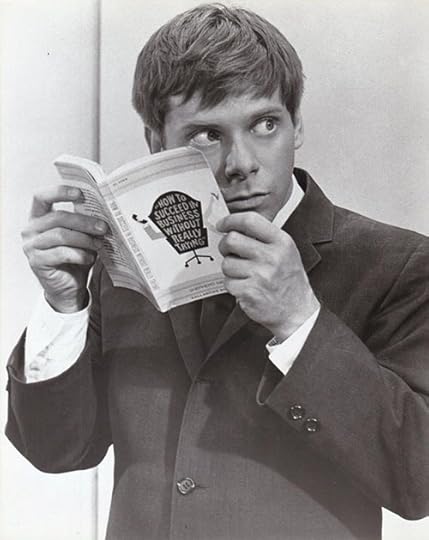
It’s hard to overstate the impact Morse made in the Broadway version of How to Succeed. The two revivals of the play find leading men/boys (Matthew Broderick, Daniel Radcliffe) desperately trying to recapture Morse’s magic. The film version of How to Succeed certainly captures Morse at his best, but on its first release coming a bit too late – post-JFK assassination, Beatles era – to be more than a minor hit…and today a cult one.
Watching the film version of How to Succeed, though, it’s difficult to understand how Morse could, well, not have succeeded further. I once described him as “Jerry Lewis goes to graduate school.” He is charming, casually manic, and plays the camera like a kazoo. I know of no other film, for whatever minor flaws, that better captures a great Broadway star performance.
What happened?
The movie roles Morse landed around that time were either underwhelming – Guide for the Married Man (1967), unworthy of him (the aforementioned Honeymoon Hotel and Quick, Before It Melts) or disliked – the uncomfortably dark comedy of The Loved One and the disastrous Oh Dad, Poor Dad, Mamma’s Hung You in the Closet and I’m Feelin’ So Sad, made the same year as the film version of How to Succeed. Oh, Dad co-stars the great Rosalind Russell and yet this hardcore Morse fan has never made it all the way through. It’s a trip to the dentist minus the Novocaine.
The second act of Morse’s career begins dismally with leads in Where Were You When the Lights Went Out (1968, a flop Doris Day picture) and the toothless Disney comedy, The Boatniks (1970). That’s Life (1968), an ambitious TV series trying to mount a Broadway musical on a weekly basis (!) was a noble failure and the last look at the vital young Bobby Morse. Ahead were a lot of TV guest star work and such indignities as playing Grandpa Munster in a TV movie. He worked in nearly 80 TV episodes and movies, sometimes as a voice actor in cartoons.
On Broadway, in 1972, Morse made something of a comeback in Sugar, a musical version of Some Like It Hot that might have been a bigger deal had the music been better. Nonetheless it ran over 500 performances. Morse played his role as Jerry/Geraldine in the national touring company as well – a bright spot in his dismal second act.
The other bright spot in this dreary middle act was, however, very bright indeed. His astonishing portrayal of Truman Capote in Tru ran almost 300 performances and won Morse his second Tony. It’s very difficult to see Morse in his funny, moving, spot-on performance as Capone, and when he emerges for a last curtain call with his Capone make-up pulled off to reveal his still youthful, tousled-hair persona intact, it’s almost a gut punch.

His third act had, of course, a delightful finish as he became Bert Cooper, the boss on Mad Men – a sizeable and important supporting role in this TV classic, with a memorable, wonderful finale. As Vanity Fair put it, “Not a bad way for Morse to go…as series creator Matt Weiner gave him a final song-and-dance number, ‘The Best Things in Life Are Free’ — a touching and characteristically ironic song choice.”
What can be said of Morse’s career with its sky-rocketing first act, its sad second one (Tru aside), and a third act that finds him on one of the great television series of all time (and with a sweet send-off to boot)? What lessons are to be learned, if any?
Let’s reserve trying to answer that until we’ve talked about Richard Roundtree.
Roundtree’s John Shaft is a major pop cultural touchstone, and one hell of a performance, particularly as seen in the three Shaft movies (Shaft, 1971; Shaft’s Big Score, 1972), and Shaft in Africa, 1973) and even in his laundered but better-than-remembered series of seven TV movies (1973-1974).
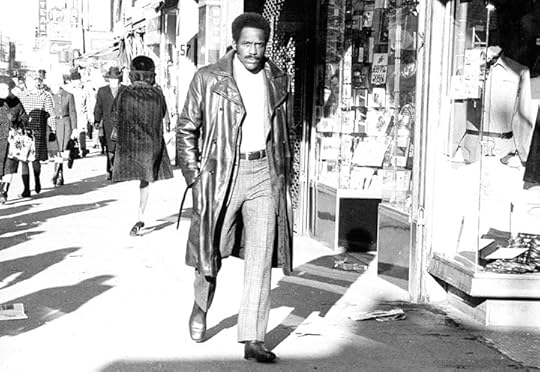
For a short span, Roundtree and his charismatic presence could be seen in major Hollywood productions, both movie (Earthquake, 1974; Man Friday, 1975) and TV (Roots, 1977); but by 1980 he was taking a guest star role on The Love Boat. Jesus. Years of TV guest shots and B (and C and D) movies lay ahead.
He was capable and deserving of so much more. Occasionally he got the chance to show it – movies like Brick (2005) and Wild Seven (2007), his appearances in the two updated Shaft movies with Samuel Jackson (including stealing the show in the 2019 Shaft, despite a relatively late entry into the proceedings). Mostly, however, it was a little of this and a little of that.
He died in 2023. Barb and I looked at a couple of the Shaft movies by way of tribute. And I wrote about him here.
The other day at the Davenport Barnes & Noble I saw, on a 50% off sale, Roundtree’s last film, Thelma (no Louise). I’d heard about this movie and its premise, and that it starred June Squibb, the elderly actress who was nominated for an Academy Award for Nebraska in 2013. So that was a little on my radar, though not the fact that her co-star was Richard Roundtree, in his last role. Anyway, I got the Blu-Ray and Barb and I watched it.

First, it’s a delightful movie. I would say it’s the best movie I’ve seen in a very long time, but for the excellent Sinners. Supporting Squibb are indie legend Parker Posey (Waiting for Guffman), Clark Gregg (Agent Phil Coulson in the Marvel Cinematic Universe), and Fred Hechlinger (Gladiator II). This collection of characters portrays and represents three generations – the grandmother whose daughter and son-in-law are considering putting her in a retirement home, and whose socially awkward (perhaps mildly on the spectrum) grandson loves and helps his grandma with amused love. The patronizing if well-meaning treatment by the middle generation of the older and younger ones are key here.
The basic premise is simple: Thelma falls victim to a phone scammer who, pretending to be her grandson, gets $10,000 out of her; and Thelma sets out on a probably ill-advised trek across Los Angeles to get her money back. It’s kind of a goofy revenge plot that is used to sweetly explore the foibles of each of the three generations. It never gets sentimental or cloying, and is often very funny and frequently touching. The icing on the cake is Malcolm McDowell (who acted in radio plays I wrote!) turning up.
Where does Richard Roundtree come in? He’s Ben, an old friend of Thelma’s, but fairly far down the list of those, as Thelma finds out through a series of phone calls that most of her old friends have passed away or are infirm. Ben is in assisted living and, after Thelma hijacks his scooter, joins her on her quest with the proviso that he get back to the retirement home in time for opening night of an in-house production of Annie, in which he is playing Daddy Warbucks.
Eccentric enough for you? I promise, it’s a hoot and a (scooter) ride and a delight.
And it’s a lovely send-off for Roundtree, who even gets one nice Shaft action moment but mostly shows off his acting chops as a quietly dignified elderly man happy in assisted living, but reluctantly ready for one more rumble. The humor and the depth of his performance, which is nimble and at times heart-breaking and others heart-warming, demonstrates what a waste his career, post-Shaft, really was.
Look. I don’t exactly feel sorry for Robert Morse and Richard Roundtree. They had been big enough early on to carve out a career thereafter – they always seemed to work, and made the lives of their fans better when either Bobby or Richard turned up on a TV show or movie and a fan could say,
“Shit! Look! It’s Richard Roundtree!” “Omigod – that’s Robert Morse!”
For a creative person, an artist, sometimes a great artist, it’s enough to be able to keep working. I understand that. I understand that choices I made, that breaks I got, that breaks I didn’t get, ended up in a career that allowed me to make a living doing something I loved. In my case, I had opportunities to write things that I was urged to take on by smart people, like my agent, but that I turned away from because I preferred to write about Nathan Heller, Quarry and Ms. Tree (among other mental children of mine). I stayed with Dick Tracy longer than some smart people thought I should. I spent more time rehabilitating Mickey Spillane’s reputation than nurturing my own.
I have no regrets.
Other than maybe I wish the likes of Robert Morse and Richard Roundtree had been blessed with the careers they deserved. That alone would have improved life on this planet.
This is the complete Tru on YouTube. This is a Chicago production, but Tru ran on Broadway for around 300 performances.
Thanks, Richard.
Bye, Bobby.
* * *I would appreciate it if you’d buy the Nathan Heller audio drama, True Noir: The Assassination of Anton Cermak at Truenoir.co. Ten episodes, under thirty bucks for all of ‘em.
M.A.C.
May 13, 2025
Fruitcake at the Last Picture House, Plus Nate Heller
We had a terrific Quad Cities premiere for our film Death By Fruitcake, starring Paula Sands, Alisabeth Von Presley and Rob Merritt. It was a packed house at Davenport’s stellar The Last Picture House, the theater that’s the brainchild of our bigtime local filmmakers Scott Beck and Bryan Woods (who brought you A Quiet Place, Heretic and more).
We had a number of cast and crew members on hand, including Paula and Rob, and I led (with producer/d.p./editor) Chad Bishop a Q and A after. I took a spill off the riser onto my back but (with help) got onto my feet to helm the Q and A. Definitely a “show-must-go-on” moment, because I am still (it’s Sunday as I write this) recuperating from my own impromptu stunt-man feat.
Despite this, it was a wonderful evening, thanks to Last Picture House manager Jameson Ritter. Our two Muscatine screenings late last year were marred by sound problems (far too soft, something we weren’t able to rectify on site), but we were nicely loud and pretty impressive on the big screen. For a little movie designed to find a home (or homes) on a streaming service(s), this kind of theatrical exhibition was a rare treat for us (and, I think, the audience).
We promoted the event with an appearance on Quad Cities Live, the afternoon show that followed Paula Sands Live on her retirement from broadcasting. It was fun seeing Paula return to the site of her huge regional success. And what a Vivian Borne she makes! Alisabeth Von Presley, our equally impressive Brandy Borne, couldn’t make it to the event (she was choreographer on a high school production in Cedar Rapids that evening). But what a thrill for Barb and me to see our Barbara Allan/Antiques characters come to such wonderful comic life.

L to R: Kyle Keil (host), Morgan Ottier (host), M.A.C., Paula Sands
Whither Death by Fruitcake? We are talking to various distributors now. I fully expect us to be streaming for this year’s holiday season. Getting on physical media is a trickier proposition as that market has just about vanished except for blockbuster films and the boutique labels, which specialize in horror and cult items, where we don’t fit. That doesn’t mean I won’t try.
If you want to help us in our filmmaking efforts, take a look at Blue Christmas on Tubi right now. Don’t wait for an invitation from Santa.
photos courtesy of The Last Picture House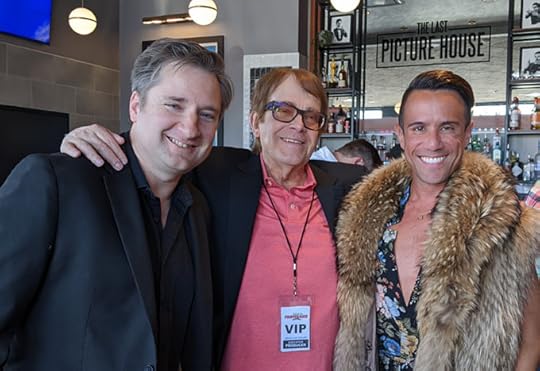
L to r: Rob Merritt, M.A.C., Tommy Ratkiewicz-Stierwalt
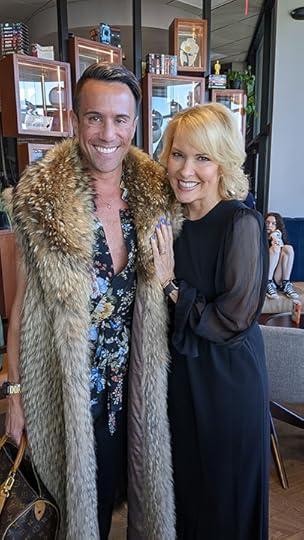
Tommy Ratkiewicz-Stierwalt and Paula Sands
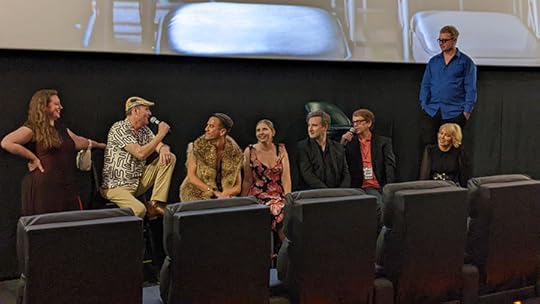
Q and A post-QC premiere at the Last Picture House. L to R: Tracy Peltzer-Timm, Chris Causey, Tommy Ratkiewicz-Stierwalt, Cassidy Ptacek, Rob Merritt, M.A.C., Paula Sands, Chad Bishop

L to R: Paula Sands, Chris Causey, Rob Merritt, Barbara Collins, M.A.C., Chad Bishop
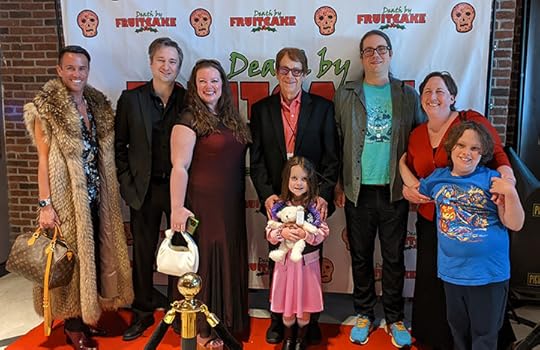
L to r: Tommy Ratkiewicz-Stierwalt, Rob Merritt, Tracy Peltzer-Timm, M.A.C., Lucy Collins, Nathan Collins, Abby Collins, Sam Collins
This link will take you to Paula Sands and me appearing on Quad Cities Live, the show that took the place of her Paula Sands Live, from which she retired after decades of Emmy-winning broadcasting. For longtime fans of my work, you should recall Paula’s wonderful appearance, spoofing herself and her show, in Mommy’s Day (1997).
* * *Here’s an unexpected but welcome review of my 1983 novel, True Detective, which introduced Nathan Heller and my format of weaving a detective story in with actual events/crimes.
It’s interesting to me that a review of a novel I wrote in 1981 and was published in 1983 would appear in 2024 (!).
Two things should be noted, however: the reviewer uses True Detective to recommend the entire series; and it’s appearing just as True Noir: The Assassination of Anton Cermak is getting some nice notice, which may have sparked this review.
True Noir is, as those of you who drop by here regularly know, a ten-episode audio drama with a full cast, sound effects, and score. I consider it the best adaptation of my work done to date (but then why wouldn’t I, having written all ten episodes myself). The cast is incredibly stellar, and our Nathan Heller – Michael Rosenbaum – just effing nails it. The score by Alexander Bornstein is mesmerizingly terrific, and the whole thing has been expertly directed and edited by Robert Meyer Burnett.
You may know Rob from his several YouTube shows (Robservations, Let’s Get Physical Media, regular guest on The John Campea Show), but he is much more than that – an accomplished film director (Free Enterprise), documentarian (Star Trek; The Next Generation), editor (Femme Fatales) and producer (Tango Shalom, aka Forbidden Tango).
All ten episodes of True Noir: The Assassination of Anton Cermak are available at truenoir.co, $29.95 for the complete audio drama – four-and-a-half-hours worth. If you are a member of the Nathan Heller Fan Club (well, there isn’t one, but you know what I mean), you will lose your non-membership in good standing if you haven’t ordered yet.
And I would welcome comments/reviews here from those of you who have enjoyed it thus far.
We will be available on other platforms eventually, but for now it’s truenoir.co. And there’s stuff to look at there, including links to episodes of my History Behind the Mystery video series (directed by my longtime collaborator, Phil Dingeldein) that looks at the real events depicted in each episode.
M.A.C.



